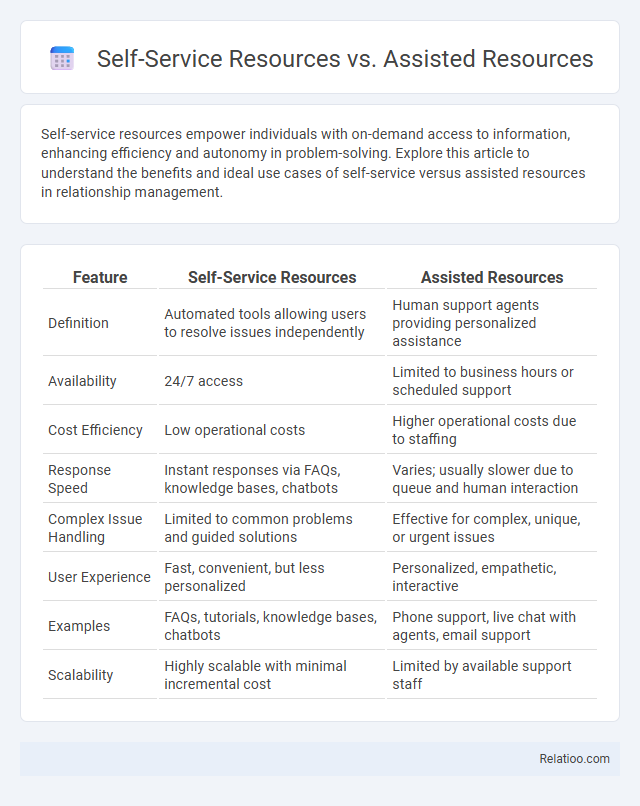Self-service resources empower individuals with on-demand access to information, enhancing efficiency and autonomy in problem-solving. Explore this article to understand the benefits and ideal use cases of self-service versus assisted resources in relationship management.
Table of Comparison
| Feature | Self-Service Resources | Assisted Resources |
|---|---|---|
| Definition | Automated tools allowing users to resolve issues independently | Human support agents providing personalized assistance |
| Availability | 24/7 access | Limited to business hours or scheduled support |
| Cost Efficiency | Low operational costs | Higher operational costs due to staffing |
| Response Speed | Instant responses via FAQs, knowledge bases, chatbots | Varies; usually slower due to queue and human interaction |
| Complex Issue Handling | Limited to common problems and guided solutions | Effective for complex, unique, or urgent issues |
| User Experience | Fast, convenient, but less personalized | Personalized, empathetic, interactive |
| Examples | FAQs, tutorials, knowledge bases, chatbots | Phone support, live chat with agents, email support |
| Scalability | Highly scalable with minimal incremental cost | Limited by available support staff |
Introduction to Self-Service and Assisted Resources
Self-service resources empower you to independently access information and tools, enhancing efficiency through FAQs, tutorials, and automated systems. Assisted resources involve direct support from experts via chat, phone, or email, ensuring personalized solutions for complex issues. Understanding the distinction helps optimize your experience by choosing the most appropriate resource based on your needs.
Definition of Self-Service Resources
Self-Service Resources are digital tools or platforms that enable You to independently access information, perform tasks, and resolve issues without direct assistance from customer service representatives. Assisted Resources involve direct interaction with support personnel who guide You through problem-solving or service processes. A Resource encompasses any asset, such as Self-Service or Assisted tools, used to provide information or assistance within an organization.
Definition of Assisted Resources
Assisted Resources refer to support mechanisms where users receive direct help from service representatives or experts to resolve issues or access information. These resources typically include live chat support, phone assistance, and personalized guidance, ensuring tailored solutions for complex problems. Unlike self-service resources, which offer independent navigation through FAQs or knowledge bases, assisted resources provide real-time interaction and expert intervention.
Key Differences Between Self-Service and Assisted Options
Self-service resources enable users to independently access information or complete tasks using tools like knowledge bases, FAQs, and automated chatbots, offering convenience and 24/7 availability. Assisted resources involve direct support from human agents, providing personalized guidance and complex problem resolution. Key differences include the level of human interaction, with self-service favoring automation and scalability, while assisted options deliver tailored experiences but require more time and staffing.
Benefits of Self-Service Resources
Self-Service Resources empower users with instant access to information and tools, reducing wait times and enhancing user satisfaction. These resources minimize operational costs by lowering the demand for assisted support while promoting autonomy and continuous learning. Organizations benefit from scalable support solutions that improve efficiency and enable staff to focus on complex issues requiring personalized assistance.
Advantages of Assisted Resources
Assisted resources provide personalized support through expert guidance, increasing efficiency and accuracy in problem resolution compared to self-service options. These resources enable users to navigate complex issues with tailored advice, reducing downtime and improving satisfaction. Enhanced communication and real-time feedback are key advantages, ensuring a seamless and effective user experience.
Use Cases: When to Choose Self-Service
Self-service resources are ideal for You when quick access to information or tools is needed without waiting for human assistance, such as FAQs, tutorials, or chatbots that handle common queries efficiently. Assisted resources work best in complex scenarios where personalized guidance or troubleshooting is required, including live support agents or technical experts. Choosing self-service saves time and empowers users to resolve straightforward issues independently, while assisted resources ensure expert help for more intricate problems.
Use Cases: When Assisted Support Is Essential
Assisted support is essential when your use case involves complex troubleshooting, personalized guidance, or urgent issue resolution that self-service resources cannot adequately address. Self-service resources like FAQs, knowledge bases, and automated tools are ideal for straightforward tasks, whereas assisted resources provide expert intervention for nuanced problems requiring human insight. Choosing the right support option ensures efficient problem-solving and enhances your overall user experience.
Impact on Customer Satisfaction and Efficiency
Self-service resources empower You to quickly access information and resolve issues independently, boosting efficiency and satisfaction by reducing wait times. Assisted resources provide personalized support that enhances customer experience in complex scenarios, ensuring higher satisfaction despite potentially longer resolution times. Balancing both approaches optimizes overall resource allocation and elevates service quality, positively impacting customer satisfaction and operational efficiency.
Choosing the Right Resource Model for Your Needs
Choosing the right resource model depends on your specific needs, workload complexity, and desired control level over the process. Self-service resources offer autonomy and rapid access, ideal for users who prefer direct management, whereas assisted resources provide expert support for complex tasks requiring specialized knowledge. Traditional resource models combine both approaches, balancing independence and guided assistance to maximize efficiency and outcomes.

Infographic: Self-Service Resources vs Assisted Resources
 relatioo.com
relatioo.com